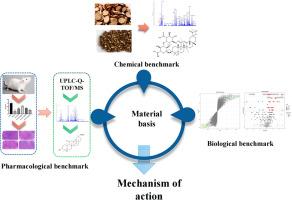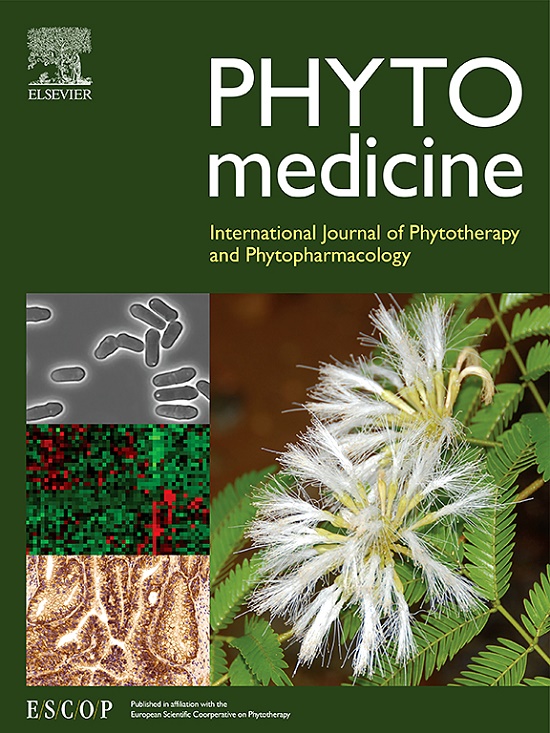蜜炒甘草治疗心律失常:结构阐释和抗心律失常活性机制。
IF 6.7
1区 医学
Q1 CHEMISTRY, MEDICINAL
引用次数: 0
摘要
研究目的评价蜜炒甘草对心律失常的治疗机制,探讨蜜炒甘草主要成分在加工前后的体内分布,阐明蜜炒甘草对心律失常的有效成分:采用UPLC-Q-TOF/MS分析生甘草和蜜炒甘草加工前后的常见成分和不同成分。方法:采用UPLC-Q-TOF/MS分析生甘草和蜜炒甘草加工前的常见成分和不同成分。应用心电图仪观察大鼠心率变化。随后,通过酶联免疫吸附试验和组织病理学检查评估蜜炒甘草对心律失常的治疗效果。代谢组学分析用于预测参与治疗反应的关键调控途径。最后,利用 RT-PCR 和酶活性测定来验证关键基因和蛋白质的表达和功能,从而深入了解其潜在机制:结果:尾静脉注射 Cacl2 溶液后,大鼠的心率增加。蜜炒甘草对心脏损伤和心动过速有一定的改善作用,其机制可能是通过对心律失常模型中的 SOD、MDA、LDH、Na+-K+-ATPase、CaM 和 CAMK2 有明显的纠正作用。在病理条件下,Metabonomics 发现心脏高度暴露于甘草亭酸 3-O-葡萄糖醛酸、异形酮苷、阿拉伯甘草次碱、18β-甘草次酸、利尿苷元、甘草黄酮醇和异利尿苷元,这些物质通过免疫调节和氧化作用具有抗心律失常的作用。值得注意的是,PCR 和 ELISA 分析表明,蜜炒甘草可能通过调节花生四烯酸途径有效治疗心律失常:这些结果表明,蜜炒甘草可预防心律失常,减轻心律失常引起的氧化应激和组织损伤。通过相关分析和代谢组学研究发现,甘草酸 3-O-葡萄糖醛酸苷、异黄酮苷、阿拉伯甘草次碱、18β-甘草次酸、利尿苷元、甘草黄酮醇和异利尿苷元可作为蜜炒甘草治疗心律失常的有效成分。此外,我们的研究结果表明,蜜炒甘草对心律失常的治疗作用可能与花生四烯酸途径的调节有关。本研究从代谢角度阐明了蜜炒甘草治疗心律失常的机制,突出了其 "补脾胃、补气、补脉 "的作用。这些发现为进一步应用蜜炒甘草和开发相关产品奠定了基础。本文章由计算机程序翻译,如有差异,请以英文原文为准。

Honey-fried licorice in the treatment of arrhythmia: Structure elucidation and the mechanism of antiarrhythmic activity
Aim of the study
To evaluate the therapeutic mechanism of Honey-fried licorice on arrhythmia, to explore the distribution of main components of Honey-fried licorice in vivo before and after processing, and to elucidate the active ingredient of Honey-fried licorice on arrhythmia.
Materials and methods
UPLC-Q-TOF/MS were used to analyze the common and different components of raw and honey-fried licorice before and after processing. Yin deficiency syndrome was established by continuous irritability and water platform sleep deprivation, and then ventricular arrhythmia model was established by injection of calcium chloride into the tail vein. Applying the electrocardiograph changes in heart rate in rats. Subsequently, ELISA and histopathological examinations were conducted to assess the therapeutic effects of honey-fried licorice on arrhythmia. Metabonomics analysis was employed to predict key regulatory pathways involved in the treatment response. Finally, RT-PCR and enzyme activity assays were utilized to verify the expression and function of key genes and proteins, providing insights into the underlying mechanisms.
Results
The heart rate of rats increased after injection of Cacl2 solution into the tail vein. Honey-fried licorice has a certain improvement effect on heart injury and tachycardia, and its mechanism may be through the obvious correction effect on SOD, MDA, LDH, Na+-K+-ATPase, CaM and CAMK2 in the arrhythmia model. Under pathological conditions, Metabonomics revealed that the heart was highly exposed to glycyrrhetic acid 3-O-glucuronide, isoformononetin, araboglycyrrhizin, 18β-glycyrrhetinic acid, liquiritigenin, licoflavonol and isoliquiritigenin are known to have anti-arrhythmic effects through immune regulation and oxidation. Notably, both PCR and ELISA analyses indicated that honey-fried licorice may effectively treat arrhythmia, potentially through the modulation of the arachidonic acid pathway.
Conclusion
These results suggested that honey-fried licorice could protect against arrhythmia and alleviate oxidative stress and tissue damage caused by arrhythmia. Through correlation analysis and metabolomics, it was found that glycyrrhetic acid 3-O-glucuronide, isoformononetin, araboglycyrrhizin, 18β-glycyrrhetinic acid, liquiritigenin, licoflavonol and isoliquiritigenin can be used as the active ingredient of honey-fried licorice in the treatment of arrhythmia. Moreover, our results suggested that the therapeutic effect of honey-fried licorice on arrhythmia may be linked to the regulation of the arachidonic acid pathway. This study elucidates the mechanisms by which honey-fried licorice treats arrhythmia from a metabolic perspective, highlighting its role in "tonifying the spleen and stomach, supplementing qi, and replenishing the pulse." These findings provide a foundation for the further application of honey-fried licorice and the development of related products.
求助全文
通过发布文献求助,成功后即可免费获取论文全文。
去求助
来源期刊

Phytomedicine
医学-药学
CiteScore
10.30
自引率
5.10%
发文量
670
审稿时长
91 days
期刊介绍:
Phytomedicine is a therapy-oriented journal that publishes innovative studies on the efficacy, safety, quality, and mechanisms of action of specified plant extracts, phytopharmaceuticals, and their isolated constituents. This includes clinical, pharmacological, pharmacokinetic, and toxicological studies of herbal medicinal products, preparations, and purified compounds with defined and consistent quality, ensuring reproducible pharmacological activity. Founded in 1994, Phytomedicine aims to focus and stimulate research in this field and establish internationally accepted scientific standards for pharmacological studies, proof of clinical efficacy, and safety of phytomedicines.
 求助内容:
求助内容: 应助结果提醒方式:
应助结果提醒方式:


